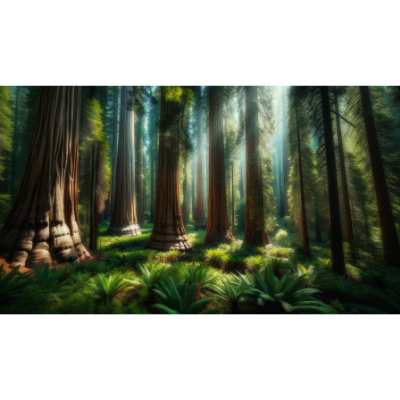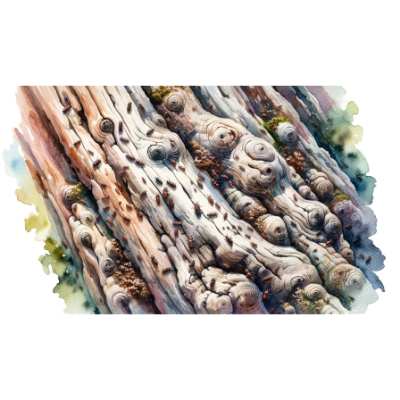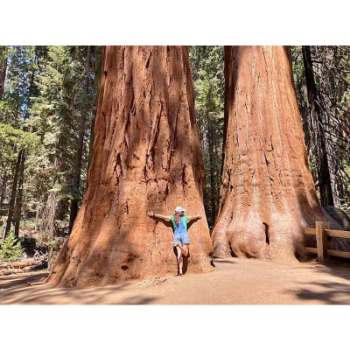Facts About Giant Sequoia Trees : There are many reasons why I find giant sequoias interesting. Some of them live for more than 3,000 years, which makes them the third longest-living trees in the world. These huge trees grow between 4,600 and 7,050 feet above sea level. They are known for being the biggest trees by volume. Many of them are between 250 and 300 feet tall, and the biggest one is more than 325 feet tall. One of the most interesting things about these trees is that their bark is very thick and resistant to fire. This bark also protects them from threats like fungus and wood-boring bugs.
These amazing trees are most notable for their sheer volume and grandeur. They are known for their enormous size and are the biggest trees in the world by volume. Most towers are between 250 and 300 feet tall, while some may rise as high as 325 feet. The really astounding aspect about huge sequoias, in addition to their breathtaking height, is their extraordinary weight and girth.
The unique bark of big sequoias is one fascinating feature. It has a lovely reddish-brown color and a silky, fibrous feel. Surprisingly, the bark develops into long, vertical plates that seem like columns. This characteristic is more apparent in older trees, where the base-region bark may sometimes reach thicknesses of 2 feet and can range in thickness from 6 to 10 inches.
The tenacious nature of these plants is equally fascinating. They have perhaps of the thickest bark of any trees we are aware of, which gives them amazing resilience to fire, fungal degradation, and wood-boring insects. Their remarkable capacity to adapt helps them survive in a variety of environments.
We will explore 30 unbelievable facts about giant sequoias, including their massive size, fascinating growth patterns, fire-resistant bark, and their important role in the ecosystems they inhabit. So, let’s delve into the awe-inspiring world of giant sequoia trees and discover the wonders they hold.
The Age And Size Of Giant Sequoias
Giant sequoias are known for their impressive age and size. These ancient trees can live for more than 3,000 years and reach incredible heights, with some measuring over 300 feet tall. Discover 30 astonishing facts about these majestic giants in this blog post.
Giant Sequoias Can Live To Be Over 3,000 Years Old
Did you know that giant sequoias can live for over 3,000 years? It’s true! These majestic trees have some incredible longevity. Here are some fascinating facts about the age and size of giant sequoias:
- Giant sequoias are among the oldest living organisms on earth.
- These trees have withstood the test of time, surviving for millennia.
- The oldest giant sequoia on record is estimated to be around 3,200 years old.
- This means that some of these trees have been standing tall since the time of ancient civilizations.
- Their impressive lifespan makes them true natural wonders.





Also Read : 10 Mind-Blowing Facts About Ginkgo Tree
The Average Height Of A Giant Sequoia Is Around 250 Feet
When it comes to size, giant sequoias are truly magnificent. Here are some intriguing details about their height:
- The average height of a giant sequoia is around 250 feet, making them some of the tallest trees in the world.
- To put this into perspective, that’s taller than a 20-story building!
- These towering giants dominate the forest canopies, creating a breathtaking sight.
- Some individual giant sequoias have even been recorded to reach heights of 300 feet or more.
- It’s no wonder these grand trees are often referred to as “living skyscrapers.”
These Trees Have A Massive Circumference, Some Reaching Over 100 Feet
Not only are giant sequoias tall, but they also have colossal circumferences. Check out these remarkable facts about their size:
- Some giant sequoias have a circumference of over 100 feet, making them among the most massive trees on the planet.
- This impressive girth requires multiple people to wrap their arms around the trunk.
- The sheer size of these trees is awe-inspiring, attracting visitors from around the world.
- Their thick bark provides excellent protection against wildfires and other natural elements.
- It’s no wonder these giants of the forest have such a commanding presence.
Giant sequoias have an astounding age and size. With lifespans exceeding 3,000 years and reaching heights of 250 feet or more, these trees are truly magnificent. Their massive circumferences, some surpassing 100 feet, only add to their grandeur. Exploring the presence and stature of these ancient beings is an experience that leaves a lasting impression.
Unique Adaptations Of Giant Sequoias
Giant sequoias, known as the largest trees on earth, boast unique adaptations. These colossal wonders thrive in the sierra nevada forests with their thick bark, fire-resistant qualities, and tremendous size that amazes all who encounter them. From their ability to withstand harsh conditions to their astonishing lifespan, these 30 unbelievable facts about giant sequoia trees will leave you in awe.
Giant sequoias, also known as sequoiadendron giganteum, possess remarkable adaptations that allow them to thrive in their natural habitats. These adaptations have contributed to their longevity and ability to withstand various challenges they may encounter. Let’s delve into some of the unique adaptations of these magnificent trees:
Giant Sequoias Have Thick, Fire-Resistant Bark:
- The bark of giant sequoias can reach up to 3 feet in thickness, providing excellent insulation against wildfires.
- This thick bark acts as a protective shield, shielding the delicate inner tissues of the tree from extreme temperatures and preventing significant damage.
They Have Developed High Tannin Content To Protect Against Insect Damage:
- Giant sequoias contain high levels of tannins, a natural chemical compound found in their foliage and bark.
- Tannins act as a defense mechanism, deterring insects and pests from feeding on the tree’s tissues, protecting them from potential damage.
The Tree’S Branches Can Actually Grow Downward Due To The Weight Of Snow:
- Giant sequoias have unique branch structure adaptations to cope with heavy snowfall in their mountainous habitats.
- Under the weight of accumulated snow, the branches of giant sequoias have the ability to grow downward, reducing the risk of breakage and ensuring the tree retains a stable form.
These incredible adaptations demonstrate the remarkable resilience of giant sequoias and highlight their capacity to endure challenging environmental conditions. By possessing thick fire-resistant bark, high tannin content, and flexible branches that adapt to heavy snow loads, these ancient trees have secured their place as true marvels of nature.
Iconic Giant Sequoia Trees
Discover 30 fascinating facts about the remarkable giant sequoia trees, renowned for their colossal size and age. Uncover secrets about their growth, lifespan, and unique characteristics in this awe-inspiring compilation.
Giant sequoia trees are truly remarkable, and their iconic status is well-deserved. From being the largest known living single-stem tree by volume to fascinating tales of longevity and fame, these majestic trees have captivated the imagination of people for centuries.
In this section, we will explore three incredible giant sequoias that exemplify the awe-inspiring nature of these ancient giants.

The General Sherman Tree Is The Largest Known Living Single-Stem Tree By Volume:
- This magnificent giant sequoia stands proudly in sequoia national park and holds the title for being the largest living single-stem tree on earth.
- With an estimated volume of 52,500 cubic feet, the general sherman tree never fails to leave visitors in amazement.
- To put things into perspective, imagine a tree so massive that it weighs around 2.7 million pounds! That’s equivalent to 1,200 cars!
Also Read : 10 Breathtaking Fun Facts About Aspen Trees
The President Tree Is The Second-Largest Giant Sequoia And Is Estimated To Be Around 3,200 Years Old:
- Located in sequoia national park, the president tree is a living testament to the passage of time and the resilience of nature.
- This incredible giant sequoia stands at a towering height of 247 feet, which is roughly equivalent to a 25-story building.
- Estimated to be around 3,200 years old, the president tree has witnessed countless generations come and go, making it a living connection to our distant past.
The Grizzly Giant Is One Of The Oldest And Most Famous Trees In Yosemite National Park:
- Nestled within the scenic beauty of yosemite national park, the grizzly giant is an ancient giant sequoia that has stood the test of time.
- This impressive tree boasts a massive 34-foot diameter and stands tall at 209 feet, captivating all who lay eyes upon it.
- Estimated to be around 2,700 years old, the grizzly giant has witnessed the ever-changing landscape of yosemite and become an icon of the park’s natural splendor.
Giant sequoia trees are more than just magnificent giants; they are living witnesses to the passage of time and the marvels of nature. From the awe-inspiring volume of the general sherman tree to the ancient beauty of the president tree and the grizzly giant, these iconic giants continue to inspire and remind us of the true wonders of the natural world.
Curiosities And Wonders Of Giant Sequoia Trees
Discover 30 mind-blowing facts about giant sequoia trees, from their incredible height and age to their fire-resistant bark and environmental impact. Unveiling their curiosities and wonders will leave you in awe of these majestic giants of the forest.
The giant sequoia, one of nature’s true marvels, never fails to captivate with its extraordinary features. Here are some unbelievable facts about these majestic trees that will leave you in awe:
The Giant Sequoia Has The Ability To Reproduce Both Sexually And Asexually:
- These incredible giants have two distinct methods of reproduction.
- Sexual reproduction occurs through the dispersal of seeds, which are typically enclosed in small cones.
- Asexual reproduction, on the other hand, happens when new trees sprout from the root system of a mature giant sequoia.
These Trees Have Incredibly Fast Growth Rates, With Some Adding 3 Feet Of Height Per Year:
- Giant sequoias are renowned for their remarkable growth rates.
- In ideal conditions, these towering giants can achieve an astounding growth rate of up to 3 feet per year.
- Such rapid growth allows them to reach awe-inspiring heights in a relatively short span of time.
Giant Sequoias Have A Unique Aroma, Often Described As A Mix Of Vanilla, Cinnamon, And Butterscotch:
- The distinctive fragrance exuded by giant sequoia trees is truly enchanting.
- The aroma has been likened to a delightful blend of vanilla, cinnamon, and butterscotch, creating an olfactory experience like no other.
- Strolling through a grove of giant sequoias offers a sensory treat of sight, touch, and smell.
These fascinating curiosities and wonders of giant sequoia trees reveal their exceptional nature and the marvels they hold. From their unique reproductive abilities to their rapid growth rates and captivating aroma, these majestic giants stand as testaments to the beauty and awe-inspiring power of nature.
Explore further and unravel the many secrets that these magnificent trees hold.
Ecosystem Impact Of Giant Sequoia Trees
Giant sequoia trees have a profound impact on ecosystems due to their sheer size and longevity. These incredible trees provide habitat for numerous species and contribute to the overall health and diversity of forest ecosystems. Discover 30 fascinating facts about these majestic giants.
Giant sequoia trees are truly incredible, and their impact on the ecosystem is just as remarkable. These majestic giants contribute to the biodiversity and overall health of their surroundings in several ways. Let’s explore how giant sequoia trees influence their ecosystem, from providing food for wildlife to creating a unique microhabitat and even influencing local climate and air quality.
The Fallen Cones Of Giant Sequoias Provide Food For Numerous Wildlife Species:
- Fallen cones from giant sequoias serve as a vital source of food for a wide range of wildlife species.
- Squirrels, chipmunks, and birds rely on the seeds found within the cones as a valuable food source.
- The abundance of these cones ensures that a diverse array of wildlife can thrive within the sequoia groves, contributing to the overall balance of the ecosystem.
The Massive Trees Create A Microhabitat That Supports Diverse Plant And Animal Life:
- The towering presence of giant sequoias creates a microhabitat within their canopies and on the forest floor.
- The thick bark of these trees provides insulation and protection, allowing a variety of plant species to grow on their trunks and branches.
- Ferns, mosses, and even smaller trees find a home on the giants, adding to the rich biodiversity of the sequoia groves.
- The dense shade cast by the enormous branches creates a unique understory that provides a suitable habitat for various shade-tolerant plants.
The Sequoia Groves Have A Significant Impact On Local Climate And Air Quality:
- Giant sequoia trees play a crucial role in maintaining local climate conditions within their groves.
- Their enormous size and dense foliage create a cooling effect in the surrounding area, providing relief from the heat on hot summer days.
- The evaporation of water from sequoia leaves increases humidity in the air, preventing excessive dryness.
- Furthermore, the extensive root systems of giant sequoias help stabilize the soil and reduce erosion, contributing to the overall health of the ecosystem.
- The trees also act as natural air filters, intercepting pollutants and improving air quality in the surrounding region.
Giant sequoias have a profound impact on their ecosystem. They provide food for wildlife through their fallen cones, create a microhabitat that supports diverse plant and animal life, and influence local climate and air quality. Their significance goes beyond their awe-inspiring size and serves as a reminder of the intricate connections within nature.
Preservation Efforts And Challenges
Preserving giant sequoia trees presents unique challenges due to their immense size and sensitivity to environmental factors. Efforts include controlled burns and tree mapping to understand their needs and protect these incredible natural wonders.
Logging of giant sequoias began in the mid-19th century but was ultimately halted due to public outcry:
- The majestic giant sequoia trees, full of remarkable history and beauty, faced a dark period in the mid-19th century when logging activities threatened their very existence.
- The unprecedented scale of deforestation led to widespread public concern, giving rise to a strong outcry against logging these magnificent trees.
- Fortunately, the collective efforts of passionate individuals and organizations brought an end to the logging operations, heralding a new era focused on protecting these living wonders for future generations.
Today, preservation efforts are focused on protecting the giant sequoia habitat from wildfires:
- The preservation of giant sequoia trees has evolved to address the significant threat posed by wildfires, which can devastate their habitat.
- Active fire management strategies, such as controlled burns and brush removal, are implemented to reduce the risk of catastrophic wildfires in these delicate ecosystems.
- Collaborative efforts involving government agencies, conservation organizations, and local communities are constantly exploring innovative approaches to safeguard the giant sequoia’s natural habitat.
The long lifespan and slow growth of these trees make them vulnerable to environmental changes:
- Giant sequoias, with their longevity of thousands of years, have endured various environmental challenges throughout their existence.
- Their slow growth and gradual adaptation mechanisms make them susceptible to alterations in their surroundings, including climate change and ecosystem disturbances.
- Conserving the delicate balance of their environment is crucial to ensuring the continued survival and prosperity of these awe-inspiring giants.
Historic Significance Of Giant Sequoia Trees
Discover the remarkable historic significance of giant sequoia trees with these 30 unbelievable facts. Explore their impressive size, centuries of growth, and vital role in the ecosystem. Prepare to be amazed by the wonders of these magnificent trees.
Native american tribes have long held cultural and spiritual significance for giant sequoias. These majestic trees have been a part of their traditions and history for centuries. Here are some interesting facts about the historic importance of giant sequoia trees:
- Native american tribes like the miwok, paiute, and yokuts consider giant sequoia trees sacred. They believe these trees have a strong connection to their ancestors and serve as a symbol of strength and longevity.
- Many tribes held ceremonies and gatherings near giant sequoias, often using these trees as meeting places and offering spaces. They also used the wood for constructing homes, making baskets and tools, and for firewood.
- The giant sequoia’s thick bark provided excellent insulation for winter shelters, protecting native american tribes from the harsh elements. Furthermore, the bark’s fire-resistant properties made it a valuable resource for creating fire breaks during wildfires.
- John muir played a crucial role in advocating for the protection of these iconic trees. He was a dedicated naturalist and conservationist who recognized the uniqueness and significance of giant sequoia trees. Muir’s efforts led to the establishment of protected areas like the sequoia and kings canyon national parks.
- Inspired by muir’s activism, the environmental conservation movement embraced giant sequoia trees as symbols of nature preservation. These trees became a powerful representation of the urgent need to protect our planet’s natural resources and conserve biodiversity.
- Today, giant sequoias continue to captivate the world with their grandeur. Visitors from around the globe flock to see these magnificent trees, appreciating their beauty and significance. The preservation of giant sequoias stands as a testament to humanity’s commitment to safeguarding and cherishing our natural wonders.
Giant sequoias not only hold cultural and historic significance for native american tribes but have also played a crucial role in the conservation movement. These trees continue to inspire awe and admiration, reminding us of the profound importance of protecting our environment.
Tourism And Recreation Opportunities
Discover 30 unbelievable facts about giant sequoia trees and immerse yourself in the world of these majestic wonders. Learn about their age, size and unique characteristics, and explore the tourism and recreation opportunities they offer. Experience the awe-inspiring beauty of these towering giants for yourself.
Giant sequoia trees are a sight to behold, standing tall and majestic in their ancient forests. These incredible giants offer not only breathtaking natural beauty but also a range of tourism and recreation opportunities for visitors to enjoy. From hiking and camping to exploring informative museums and guided tours, there are endless ways to immerse yourself in the wonder of giant sequoias.
Visitors Can Enjoy Hiking, Camping, And Scenic Drives In Giant Sequoia Forests:
- Hiking: Lace up your boots and embark on the numerous hiking trails that wind through the giant sequoia forests. Whether you’re looking for a leisurely stroll or a challenging trek, there are trails for every skill level. As you navigate these paths, you’ll be surrounded by towering trees and be able to witness firsthand their grandeur and magnificence.
- Camping: Set up camp amidst the giants and experience the serenity of sleeping under a canopy of ancient trees. Many campgrounds are available in the vicinity of giant sequoia forests, providing the perfect opportunity to disconnect from daily routine and immerse yourself in nature. Enjoy the crackling of a campfire, the crisp mountain air, and the chance to spot wildlife in their natural habitat.
- Scenic drives: If you prefer a more leisurely way to appreciate the beauty of giant sequoias, take a scenic drive through these magnificent forests. Winding roads will lead you through towering groves, offering glimpses of these awe-inspiring trees from the comfort of your vehicle. Take your time, roll down the windows, and bask in the stunning views that surround you.
The Giant Forest Museum Provides Educational Resources About These Majestic Trees:
- Interactive exhibits: The giant forest museum is a treasure trove of educational resources about giant sequoias. Step inside and discover interactive exhibits that delve into the ecology, history, and significance of these incredible trees. Learn about their life cycle, their adaptations to their environment, and the importance of their conservation.
- Ranger-led programs: The museum also offers ranger-led programs that provide a deeper understanding of giant sequoias. Join a guided walk or talk led by knowledgeable rangers who share their expertise and passion for these ancient wonders. Gain invaluable insights into their ecology, cultural significance, and ongoing conservation efforts.
Many National Parks And Protected Areas Offer Guided Tours And Interpretive Programs About Giant Sequoias:
- Guided tours: National parks and protected areas where giant sequoias thrive often offer guided tours led by knowledgeable guides. These tours allow visitors to explore the forests with an expert who can provide insights into the unique features of giant sequoias. Learn about their impressive size, their ability to withstand fire, and the delicate balance of their ecosystems.
- Interpretive programs: Educational programs focusing on giant sequoias are frequently available in national parks and protected areas. These programs aim to enhance visitors’ understanding of the natural and cultural history associated with these remarkable trees. Through interpretive talks and hands-on activities, participants can deepen their appreciation for the significance and conservation of giant sequoias.
Visitors to giant sequoia forests have a myriad of opportunities to enjoy hiking and camping amidst the towering giants. The giant forest museum enriches the experience with its educational exhibits and ranger-led programs. Moreover, many national parks and protected areas offer guided tours and interpretive programs that provide deeper insights into these majestic trees.
So, venture into the land of giant sequoias and immerse yourself in their awe-inspiring beauty.
Frequently Asked Questions For 30 Unbelievable Facts About Giant Sequoia Trees
What Are Some Unique Facts About Sequoia Trees?
Sequoia trees are unique in many ways. They are the tallest trees in the world, growing up to 300 feet. Their massive trunks can reach a diameter of 30 feet. These majestic trees can live for thousands of years, making them some of the oldest living organisms on earth.
Sequoias have thick, fire-resistant bark that protect them from wildfires. They also have unique cones that release seeds only when exposed to intense heat. The wood of sequoias is lightweight and resistant to decay, making it highly valuable. These remarkable trees are found only in specific regions of california and are a symbol of resilience and longevity in nature.
Sequoias are truly awe-inspiring and offer a unique experience for anyone fortunate enough to encounter them.
What Is Unique About Giant Sequoia?
Giant sequoias are unique because they are the largest trees on earth. These massive conifers can reach heights of over 300 feet and have trunks that can measure more than 30 feet in diameter. Their size is truly awe-inspiring! In addition to their colossal stature, giant sequoias also have incredible lifespans, with some living for over 3,000 years.
These trees can withstand various environmental conditions, including fire, due to their thick, fire-resistant bark and high tannin content. Giant sequoias also have tiny, scale-like leaves and produce small, woody cones containing seeds. These cones release their seeds, which are only around a quarter of an inch long, during periods of drought or heat.
Overall, giant sequoias are remarkable organisms that hold a prominent place in the natural world.
How Long Can A Sequoia Tree Live?
Sequoia trees can live for more than 3,000 years. They are known for their exceptional longevity. Within this timespan, sequoias can grow to be the largest trees on earth. These majestic giants can reach heights of over 300 feet, with diameters exceeding 25 feet.
They are able to withstand various environmental factors like drought, insects, and diseases due to their thick bark, which helps protect them from harm. Sequoias also have a unique trait of sprouting from their trunks and branches, allowing them to regenerate after experiencing damage or fires.
Despite their incredible lifespan, sequoia trees are under threat from climate change and human activities, highlighting the need for conservation and protection of these magnificent natural wonders.
How Many People Does It Take To Hug A Sequoia Tree?
To hug a sequoia tree, it typically takes several people due to its massive size. The number of people needed depends on the circumference of the tree. Sequoias can have trunks as wide as 30 feet, so it requires a coordinated effort.
The more people involved, the easier it is to complete the hug. These majestic trees are a sight to behold, and hugging them can be a unique and awe-inspiring experience. So gather a group of friends or family members and embrace the towering sequoia together!
Conclusion
These unbelievable facts about giant sequoia trees shed light on their remarkable existence and significance. From their exceptional height and massive girth to their resistance to natural disasters and ability to live for thousands of years, these ancient trees continue to astonish scientists and nature enthusiasts alike.
The unique adaptations that allow giant sequoias to thrive in their specific ecosystems and their crucial role in maintaining biodiversity further highlight their importance. Beyond their scientific significance, these majestic trees possess a spiritual and aesthetic allure that captivates visitors to their groves.
Exploring the wonders of the giant sequoia trees reminds us of the awe-inspiring beauty and resilience of nature. Preserving these remarkable living monuments is essential to ensure that future generations can continue to marvel at their grandeur and draw inspiration from their enduring presence.
So let us cherish and protect these ancient giants, for they truly embody the wonders of our natural world.
